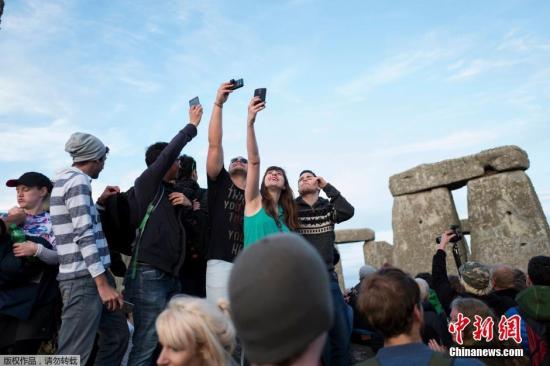New ruins found near the famous British prehistoric site "Stonehenge"
China News Agency, London, June 23 (Zhao Xingyiping) A team of British archaeologists announced to the outside world on the 22nd that more than 20 huge potholes were found near the remains of the British "Stonehenge", one of the famous prehistoric sites in human history . Archaeologists say this is the largest prehistoric site ever discovered in Britain.
Data picture: People hold up their mobile phones to take selfies in front of the boulders.
At the annual "Summer Solstice" event of the "Stonehenge" held on the same day, the team of archaeologists announced this "great discovery": most of the pits are 10 meters in diameter and 5 meters deep, and there are more than 20 large and small. Arranged in a circle, forming a huge circle of 2 kilometers long, surrounding the "Durington Wall" and "Giant Tree Site" in its center. They are named "Durington Rock Pit" and are 3 kilometers away from the remains of "Stonehenge".
The team of archaeologists is composed of more than 10 researchers including the University of St Andrews, University of Birmingham, University of Warwick, University of Glasgow, etc., using the most cutting-edge archaeological means, and also combining the most traditional detection methods to survey the "Durington Stone The completion time of the pit can be traced back to the Neolithic period of 4500 years before the appearance of "Stonehenge", "This will write the latest chapter for the Neolithic research."
British archaeologist Vincent Gaffney said: "This is an unprecedented discovery in British history. Let us researchers startled, so close to the "Stonehenge", these craters never be found."
Dr. Nick Snashall, a British "Stonehenge" archaeologist, believes that "believing that the builders of "Stonehenge" had lived and lived in the "Durington Rock Pit", this may be a solution to the historical secrets of "Stonehenge" The key is to provide a new perspective for studying and understanding the life of the ancestors of the Neolithic Age."
The "Stonehenge" prehistoric remains are one of the most famous man-made prehistoric sites in human history and one of the most popular tourist attractions in Britain. In 1986, it became the first United Nations World Heritage Site in the United Kingdom. It was built between 4000 BC and 2000 BC. (Finish)

